
| Abiqua Dogs |
| Abiqua Pumi |
| About Pumis |
| Our Dogs |
| News |
| Our Home |
| Grooming |
| Pumi Standard |
| Getting a Puppy |
| Puppies |
| Links |
We have been testing the DNA on our Pumi to get a better understanding of what genes determine the different colors. We started doing this when a Pumi litter was born in the US, and half of the puppies were a black and tan pattern which is a disqualification according to the standard for the breed. We had also had this pattern show up in some of our litters, but it had been just one puppy in a litter. We wanted to have a better idea of where and how this color pattern might appear.
We orignally tested 6 dogs, some of ours and some others. VetGen did the testing for free since they had no information on the Pumi. We have subsequently tested all but one of our current dogs, and have recently included more the B and E locus genes in addition to the original K and A locus, just because we're curious!
If you would like more information on color genetics, you can go to the following links:
-
Genetics of Coat Color and Type in Dogs and more specifically Puli Coat Color DNA Study
The following table lists the genes that we have tested in the order of their dominance by locus. For example, "Ay" is dominant to "aw" is dominant to "at" is dominant to "a". Another way to write this is "Ay > aw > at > a".
| K Locus | |
| KB | Self colored (dominant). Overrides Ky and A locus genes. |
| ky | Not self-colored. Allows A locus gene to show. |
| A Locus | |
| Ay | Fawn/sable |
| aw | Wild agouti |
| at | Black & tan |
| a | Recessive black |
| B Locus | |
| B | Black nose, coat color |
| b | Liver nose |
| D Locus | |
| D | Normal color determined by other color genes |
| d2 | Dilute color, gray nose, born gray, not black |
| d3 | Apparently this is a Pumi trait for born gray color |
| E Locus | |
| Em | Mask (as an Afghan with a black mask) |
| Eg | Grizzle/domino (as in Afghan) |
| Eh | Sable |
| E | (None of the above) |
| ee | Yellow, orange, or red |
Gene Distribution in the Pumi
What we have determined from the few dogs that have been colored tested (that we are aware of), is that the black and tan gene is very common in Pumik. Below is the distribution of genes from the 50 or so Pumik that have been tested (each has two copies of the gene).
A Gene |
Number |
% |
| Ay | 14 | 14% |
| aw | 10 | 10% |
| at | 53 | 53% |
| a | 23 | 23% |
Total |
100 | 100% |
Below is the distribution of the K gene in those 14 Pumik:
K Gene |
Number |
% |
| KB | 68 | 68% |
| Ky | 32 | 32% |
Total |
100 | 100% |
Below is the distributio of the D gene. Fewer Pumik have been tested for this gene. (not included is the newly-discovered d3 gene.)
K Gene |
Number |
% |
| D | 68 | 85% |
| d | 12 | 15% |
Total |
80 | 100% |
Knowing this is a small sample of dogs, but fairly diverse (Hungarian, Finnish, and Swedish dogs) and most of them not related, it can be deduced that the black and tan gene is quite common in Pumik, but that it is not allowed to express itself due to the frequency of the "KB", "Ay", and "aw" genes which are all dominant to it.
White
Having tested all of 3 dogs on the E locus, we suspect that E locus controls the "white" in a Pumi, i.e. they really aren't white, but very light yellow. A dog of ours that has produced white was "Ee" and his daughter, who is white, is "ee". More testing should be done on this gene to determine if this is the only gene controlling the white, but the latest research is coming to this conclusion also.
Fako (Fawn) and Pumi breeding
Let's go another step farther, knowing that some of the original Pumi breeders did not want fako (fawn) Pumik because they thought they weren't purebred. When a Pumi is fako, it must be "kyky" in order to express the fako (Ay) gene. But when you start incorporating more and more "ky" genes your breeding, as soon as you have a "kyky" puppy, any other A locus genes can show up. For example, one of our dogs is a silver gray, but her DNA is KBKB/atat. She is homozygous black and tan on the A locus, but because she is "KBKB", she is silver gray. Even if she was "KBky", it would still not show up because of the single, dominant "KB" gene. When you start incorporating more and more "ky" genes that all fawn dogs must have, the other colors can start appearing in your puppies.
This is just my theory on why there is resistance to the fako colored dogs. Of course, the early breeders didn't have access to DNA profiles, they just knew that when they started breeding with fako dogs, other colors showed up.
Black Pigment
All but one of the dogs tested at the B locus were "BB".
Our Dogs
Below are the pictures and genetic information on our dogs that have been tested. They are shown from darkest to lightest. Each Pumi has two copies of each gene, one from each parent.
Color Description |
Self-Color |
Fawn, black/tan, rec. black |
White |
Dilute |
Nose Color |
||||||
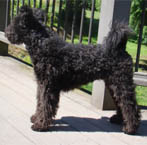 |
Black with a few white hairs, but a brownish cast to the soft hair. | KB |
ky |
Ay |
Ay |
E |
e |
||||
| Dark gray, almost black even into old age. Soft hair is lighter color, hard hair is black. | KB |
KB |
a |
a |
|||||||
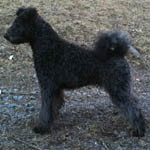 |
Dark gray, lighter on the legs and face. | KB |
ky |
aw |
a |
E |
e |
||||
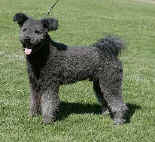 |
Dark gray, lighter on the legs and face. | KB |
ky |
at |
a |
||||||
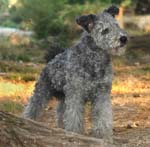 |
Silver gray. Harsh hairs are black-tipped. Can look different shades depending on amount of hard hair. | KB |
KB |
aw |
at |
E |
e |
D |
D |
||
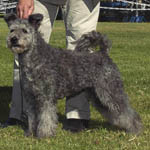 |
Silver gray. Harsh hairs are black-tipped. Can look different shades depending on amount of hard hair. | KB |
ky |
at |
a |
E |
e |
||||
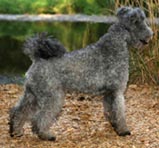 |
Silver gray. Harsh hairs are black-tipped. Can look different shades depending on amount of hard hair. | KB |
KB |
at |
a |
E |
e |
D |
d |
B |
B |
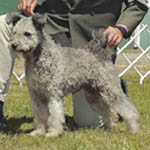 |
Silver gray. Harsh hairs are black-tipped. Can look different shades depending on amount of hard hair. | KB |
KB |
at |
at |
E |
E |
D |
D |
B |
B |
 |
Very light silver,
but still has puppy coat. |
KB |
ky |
at |
at |
E |
e |
D |
D |
||
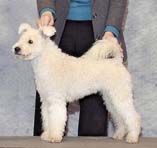 |
Fawn. Born with black-tipped hair, but lost them as she grew older. No gray shadings. | ky |
ky |
Ay |
at |
E |
e |
||||
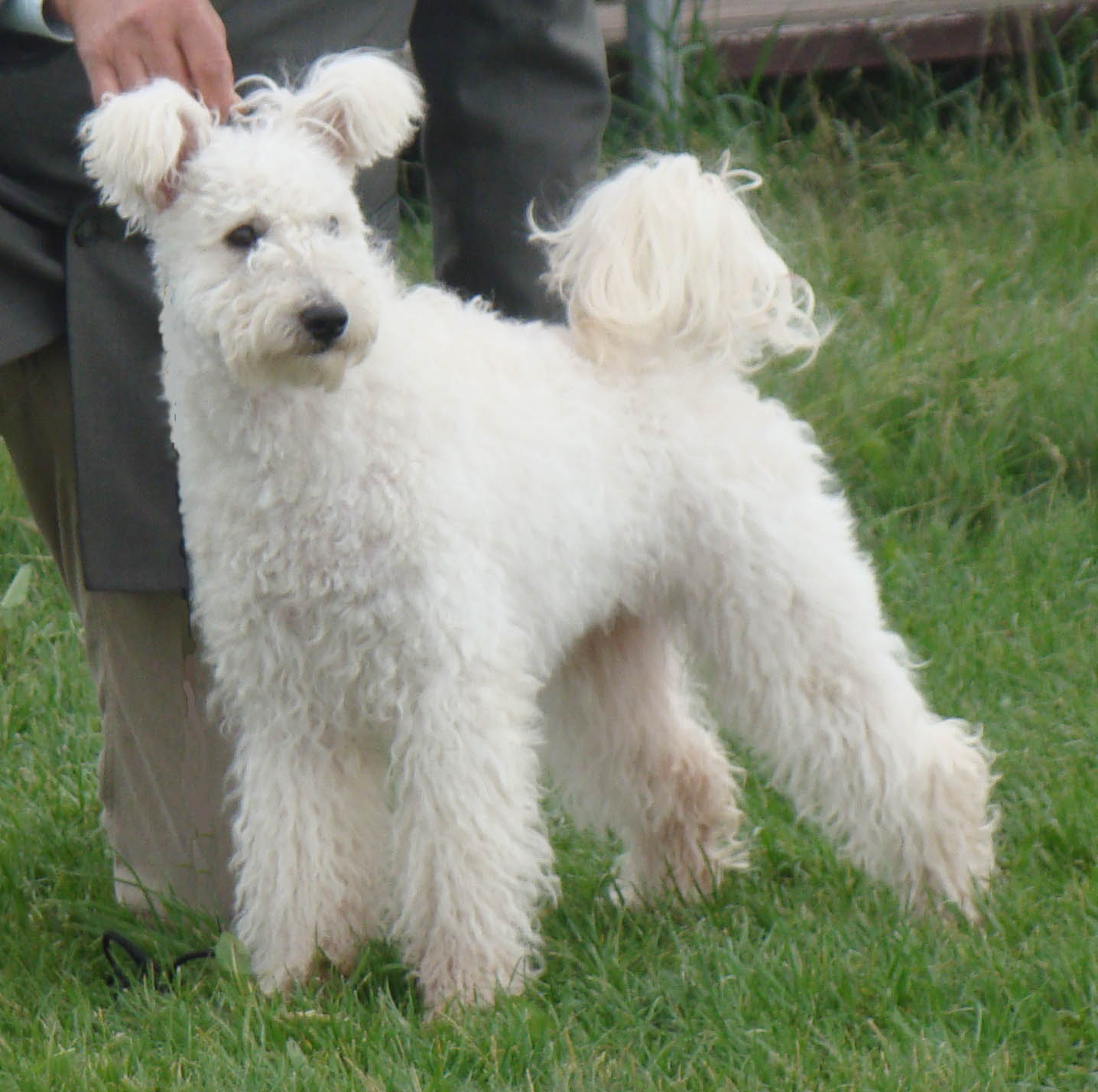 |
White. Good nose and eye pigment. Her nose fades when she's coming into season, then comes back. | KB |
KB |
a |
a |
e |
e |
D |
D |
B |
B |
In Conclusion
Research is still on-going and they still haven't discovered the fading/silvering gene (that turns a black puppy to a silver adult). As we originally thought coat color inheritance was much simpler than this, what we currently know will someday be augmented with something possibly even more complicated involving more genes.
I am hoping that Pumi breeders will use this information, not to eliminate disqualifying color genes in their breeding program, but to add to all of the bits of information that go into making good breeding decisions.
I would appreciate any input from readers, or if your dog has been genetically color tested and you would like the results incorporated into this study, please email me at chris@abiquadogs.com.
- Chris
Copyright © 2000 All Rights Reserved
Last updated:
03/26/22